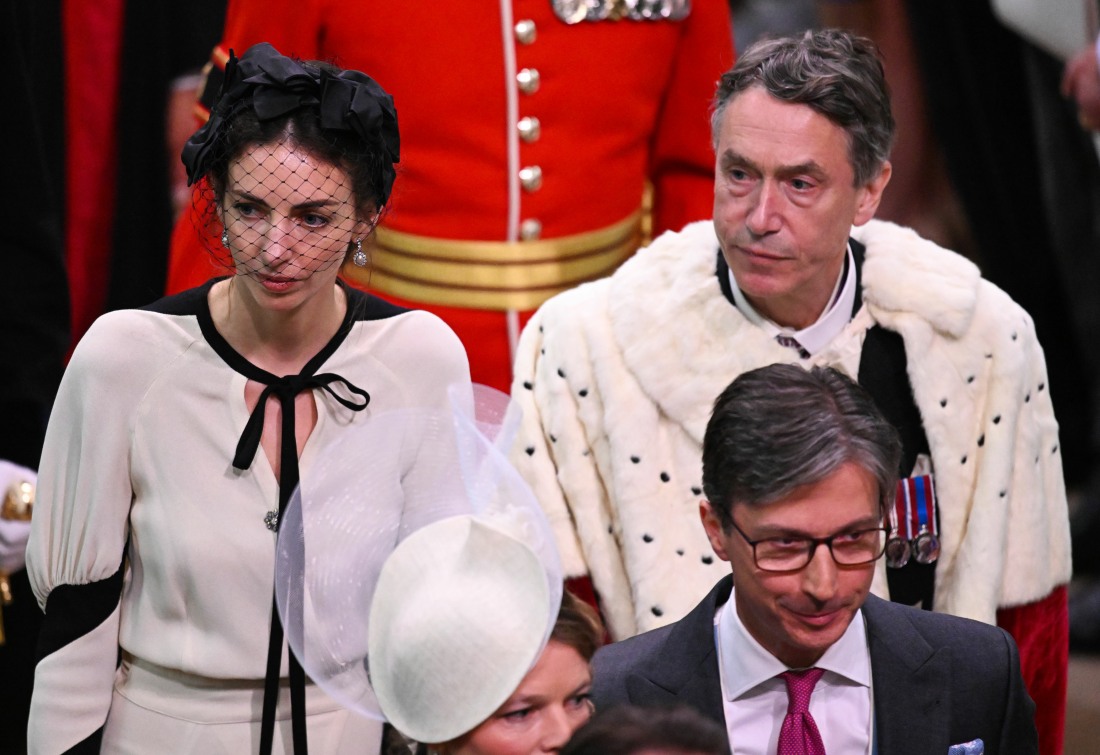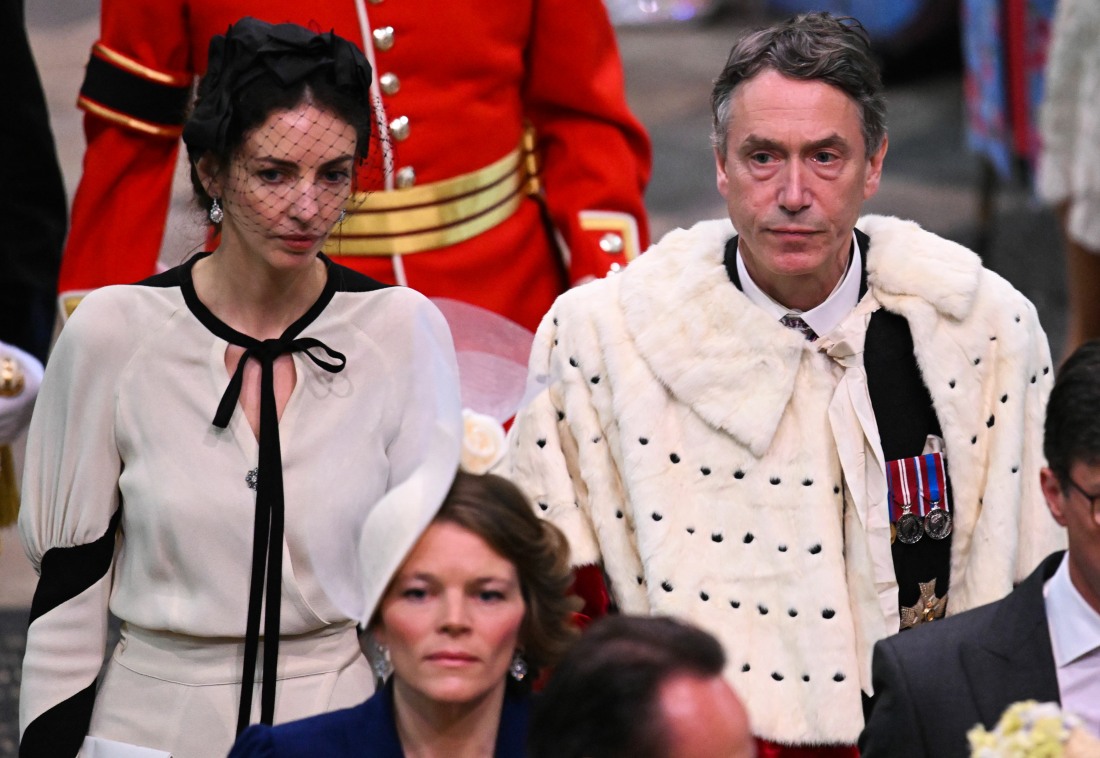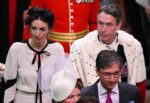One of the funniest side-stories with this year’s “Where Is Kate” phenomenon was the focus on Rose Hanbury, Rose’s marriage to the Marquess of Cholmondeley, and the art and antiquities in their grand estate, Houghton Hall. As older photos of Rose and David circulated on Western social media, Chinese social media users also started looking closely at the photos, and Chinese art people soon discovered the Cholmondeley’s vast Chinese art collection. Many of the pieces of Chinese art within Houghton Hall looked as if they were from the Qing Dynasty, and Time Magazine ran a deep dive into why that is. David Rocksavage (the Marquess) is descended from the wealthy Sassoon family, a family which was very active in import/export in Asia. Time Mag’s art historians didn’t know if the Qing Dynasty pieces were “looted” or simply purchased more than a century ago and brought to England. While Time Mag covered the story, the British media mostly sat on their hands about Rose and David, like always. They waited until now to publish any kind of coverage, and they likely waited until the Cholmondeleys made a statement about the art:
It is one of the country’s most stunning stately homes – a 106-room mansion that draws thousands of visitors each year to admire its architectural history. But now Houghton Hall, family seat of David Cholmondeley, the 7th Marquess of Cholmondeley, is under scrutiny from Chinese internet sleuths who claim the neo-Palladian pile contains antique valuables looted from the Qing Dynasty.
Images of the Grade I listed house, commissioned by Sir Robert Walpole in 1722, have gone viral on social media sites, despite assurances from the estate that no items among the Hall’s contents had been stolen. In China, armchair detectives have taken to TikTok to accuse the Marquess, 63, and his wife Rose Hanbury, 40 – neighbours of the Prince and Princess of Wales – of living with pillaged loot they inherited from his illustrious ancestors, the Sassoons.
Nicknamed ‘the Rothschilds of the East’, the Sassoon family amassed a fortune dealing in textiles, tea, and opium across India and China in the 19th Century. The height of their business coincided with China’s ‘century of humiliation’ from 1839 to 1945, where millions of valuable artefacts were plundered by British and French soldiers. The Qing dynasty ran from 1644 to 1911. Identifying which items from this era were stolen and which were legally acquired is difficult but that has not stopped baseless allegations being made against the Cholmondeleys. One person on Xiaohongshu, an Instagram-like site, shared images of the Hall’s interior and said: ‘The Sassoons started to accumulate their wealth by looting late Qing China.’
While David, the current Marquess, is descended through his father from the Sassoons, the estate said the items in question were not heirlooms that were inherited through his family. A Houghton Hall spokesman said: ‘The items of Chinese origin in the photographs to which you refer were purchased by the Walpole family, the original owners of Houghton, during the 18th Century, mid-Qing Dynasty, mostly through agents rather than in China directly. The items were not looted but mostly made for export to Europe. It would be hard to find a country house collection, whether private or owned by the National Trust, that does not exhibit items acquired in or from China. This is true of most European and American collections.’
That statement is so interesting – Houghton Hall’s spokesperson (likely Rose or someone working closely with her) did a deeper dive into the provenance of the Chinese art housed in Houghton and they came up with “it wasn’t David’s Sassoon grandmother, it was actually several more generations back.” I actually didn’t know that wealthy English families were purchasing Chinese art – through a third party – back in the 18th century. I mean, colonizers gonna colonize, although Houghton Hall’s spokesperson seems to be indicating that Qing Dynasty artists were making pieces specifically for export to Europe? I don’t know enough about the history of Asian art export, but it will be interesting to see if actual historians chime in on this and try to fact-check the Cholmondeleys’ story.
Photos courtesy of Avalon Red.
- Sarah Rose Hanbury and David Cholmondeley, 7th Marquess of Cholmondeley, at the Coronation of King Charles III at Westminster Abbey, London, on 06 May 2023.,Image: 774202176, License: Rights-managed, Restrictions: , Model Release: no, Credit line: James Veysey/Shutterstock / Avalon
- Sarah Rose Hanbury and David Cholmondeley, 7th Marquess of Cholmondeley, at the Coronation of King Charles III at Westminster Abbey, London, on 06 May 2023.,Image: 774202187, License: Rights-managed, Restrictions: , Model Release: no, Credit line: James Veysey/Shutterstock / Avalon
- Sarah Rose Hanbury and David Cholmondeley, 7th Marquess of Cholmondeley, at the Coronation of King Charles III at Westminster Abbey, London, on 06 May 2023.,Image: 774202212, License: Rights-managed, Restrictions: , Model Release: no, Credit line: James Veysey/Shutterstock / Avalon
- Sarah Rose Hanbury and David Cholmondeley, 7th Marquess of Cholmondeley, at the Coronation of King Charles III at Westminster Abbey, London, on 06 May 2023.,Image: 774271057, License: Rights-managed, Restrictions: , Model Release: no, Credit line: James Veysey/Shutterstock / Avalon
- Sarah Rose Hanbury and David Cholmondeley, 7th Marquess of Cholmondeley, at the Coronation of King Charles III at Westminster Abbey, London, on 06 May 2023.,Image: 774271096, License: Rights-managed, Restrictions: , Model Release: no, Credit line: James Veysey/Shutterstock / Avalon


















Legally could mean that someone way back did the looting and then these pieces were sold to them so they believe they got them legally because they didn’t go and outright raid China for them but still they would be looted artifacts.
This is likely what truly happened as these practices were rife throughout the world.
“I actually didn’t know that wealthy English families were purchasing Chinese art – through a third party – back in the 18th century.”
It is true. The Imperial Russian family, among many others, also purchased many “treasures” through third party dealers.
The expiation is totally plausible as Robert Walpole, 1st Earl of Orford, was an avid collector who spent himself into big debt collecting. The 2nd Earl of Orford finished offed the family coffers with gambling.
This seems the ‘Parthenon Marbles’ story all over again: they weren’t looted, they were sold to us.. yes, by whom though?
It does sound like it, they really seem to think that if they didn’t loot it themselves they’re not guilty 🙄🙄🙄
The Dutch and others were highly successful agents for the trade in tea and porcelain from the 1600s on—there was a gigantic market in Europe primarily that Chinese businesses happy to supply. Delftware was made specifically for the Dutch/Euro market. The looting really got going with the opium wars in the 19th century—which were all about the massive trade imbalances those European countries had with China.
China can manufacture products for export? No way! 🤯
there were several times that there was a far eastern artifact craze in europe for anything oriental, from the famous delft blue to cabinets, fabrics that were used as wall hangings and clothes not only from china but certainly also from japan that were traded through dutch tradingposts like dechima that held an exclusive monopoly status for more than 200 years (1649 to 1859) and didnt depend on looting or warfare.
Silks, tea, ceramics, yes–but artwork such as screens & scrolls for trade? In the 18th century? Not sure but I also don’t know enough.
Do your research there was a thriving market in Europe for purpose made Chinese ceramics in fact a lot were sent over unpainted and finished off in Europe. Time and time again these pieces turn up om the UK Antiques Roadshow tv program including urns, tea sets, dinner ware and all sorts of decorative pieces.
I don’t know if I want to believe Houghton Hall’s excuse, seeing that the ties to the Sassoon family and their profiting from the opium trade are a fact. And the brutal wars with hundreds of thousands of casualties that were fought to get what the West wanted.
But many royals and nobility had pieces of e.g. chinoiserie furniture, sometimes made to specifications – color, decor, what kind of wood – in China, and some courts even had Chinese woodworkers and (silk) tapestry weavers come to Europe for their work.
So… it could be a bit of both – some looted, some paid for.
What I didn’t like though: Rose was blamed for the actions of her husband’s family. Long live the patriarchy. /-s
When I read the Time article shared in a previous post the pictures that included the Chinese pieces made me wonder what specific details of the pieces made them conclude they were stolen and not export items.
Also at Kaiser, in the early modern period Europeans were even getting dinnerware made in China that were decorated with their family’s heraldic devices.
That’s exactly what happened. The Chinese realised how popular their blue and white plates were in Europe and filled ships to take to England and Europe. This was at a time when English plates were lumpy and ugly. Dutch delft ware came about due to people wanting blue and white china but not being able to afford export ware from China which was very high end and very expensive.
@Cathy, that’s right: I know I’ve seen episodes of Antiques Roadshow where the experts will say that about some of the items people bring to be assessed. I’m trying to remember if this was also mentioned in “Two Years in the Forbidden City” (which is a very interesting autobiographical account by “Princess Der Ling” ) and how they would give Westerners gifts of Chinese art that they personally didn’t value much themselves.
With that said, I’m not making any judgment on the veracity of Houghton Hall’s claim. As others have mentioned, things that were legally purchased may have been illegally obtained by the sellers.
Idk…Qing dynasty was weird. A story is coming to mind: I believe the Qing sold off tons of porcelain and jewels for virtually pennies because they didn’t value it but foreigners did. Could be wrong but that’s ringing a bell.
You could do the same with old American clothing in Japan. At least in the 1980s-2000s, there was a big Japanese market for postwar Americana. I guess because Japan itself was so poor after WW2, they wanted pop culture artifacts they’d missed out on when new.
I’ve seen alot YouTube videos of interior designers showing off their houses and most of them have chinoiserie. This situation has me wondering if all those pieces were originally stolen from China.
Chinoiserie was also made within Europe so, in addition to exportware, it is unlikely all the pieces you saw were stolen.
Chinoiserie was art made by Europeans imitating Chinese/East Asian style art. So not looted. You can argue it fetishized Chinese art but anything termed Chinoiserie was usually made by white European person.
I have a ton of Chinoiserie. We used to buy it at Bombay Company; now it’s Home Goods.
You know where I’ve never seen chinoiserie? In China, lol.
Sorta like chop suey, in the Chinese restaurant realm?
Wow! They are throwing the entire aristocracy (and the Royal’s) under the bus with this statement and I’m loving!! David and Rose aren’t going to be too popular with their friends!!
Why sure, everybody’s got these Chinese artifacts of dubious provenance!
I find it interesting that the Fail is even covering this. Rose has been pretty untouchable, maybe they view this as a way to dance around the edges of the scandal until the dam breaks?
And not to thread-jack but the front page of today’s Fail has an inset of Charles and then a huge headline about “250 Needless Deaths Each Week due to Agonising Waits in A&E,” while surprisingly the Sun went full sycophancy. I would’ve expected the reverse from Camilla and Will’s pet papers.
Could mean nothing, could be the Fail is getting tired of covering this mess up.
Well maybe if the alleged affair is over (and particularly if she ended it) maybe Pegs doesn’t care so much about her being thrown to the wolves now?
Realistically speaking, William likely regards EVERYONE other then himself as required to take the hit when he himself is threatened. Possibly including George. Also, I am pretty certain that the aristocracy considers it something of an honor to protect a future monarch, especially when it’s something as silly (to them) as rumors of an affair.
They really only got serious about it when it moved from gossip sites and social media to mainstream news and talk shows. If it goes past a certain point it’s going to turn into an Andrew Parker-Bowles situation and David Rocksavage will be socially obliged to divorce his wife. Because your wife having an affair means nothing, gossip about your wife having an affair with the future King is just fine, but if it is confirmed by one of the parties on national television and becomes a major news item then that is a bit too much shame to be dealing with.
Chinoiserie was extremely popular in Europe during the late 17th century up through to the 19th century, and still has popularity today. The Chinese did, for some time, manufacture and trade cloisonne and other items to Europe. It is entirely possible that families like the Sassoons did help themselves to some artifacts after China was carved up between imperialist powers, but that doesn’t change the fact there was a booming trade for Chinese items for years.
It stayed that way until the Europeans were able to reverse engineer how the Chinese made porcelain, started their own domestic markets, and began creating some of their own chinoiserie items. See one Brighton Pavilion for example. Also, with time, chinoiserie fell out of fashion. But there’s still a market today for chinoiserie items, and they can sell for a hefty price tag.
There are many essays, articles, and even books about 18th-century Chinese export wares, which were, by definition, made for the foreign art market. See for example: https://www.metmuseum.org/toah/hd/ewpor/hd_ewpor.htm
If this house really contains looted works, an expert could verify that if not from images than from close looking, especially examining the reign marks on the bottom. Porcelains made for the imperial household differ in important ways from export ware (not an expert, so I can’t point to specifics, but quality, imagery, even style of the marks all play a role)
Thanks for the link!
Historically this actually makes a lot of sense. There was a lot of fetishization of Asian culture in the 18th century. British aristocracy spent a lot of money on art from the Asian diaspora.
So this article is interesting because I’ve seen in a lot of historical homes (mostly Europe but some in North America) with the Chinoiserie style which was the European interpretation of Chinese and East Asian style art. It was very popular in the 1800s and everyone who was anyone in high society typically had at least one room in the chinoiserie style. And for the most part this type of decor I’ve seen on walls/furniture were made by Europeans, not Chinese artists. And I see others above me have also mentioned the Chinoiserie style being very popular and en vogue in Europe and it definitely was.
BUT Houghton Hall doesn’t seem to have a Chinoiserie room but legit furniture either looted/purchased directly from China. We’ll never know which one it is but I think it’s good to put them on notice. Rose and David need to be aware of what they put out in the world because it may come back to haunt them.
I think it could be a little bit of column A and a little bit of column B. Column A is the porcelain was produced for export and sale to Europe. Column B is things that were sold/acquired through practices we’d view as shady today.
These people are doing too much now because they got in the radar of US media. Didn’t care when it was innuendo in Tatler. Anyway a house this old with antiques like this, and a family history they have, probably acquired some of these artifacts by hook or by crook but unless there is a formal legal complaint, its just speculation at this point.
Everyone else stole, looted, paid pennies for a poc’s art definitely not through intimidation or colonization. Our shitty inequitable to others but profitable and beneficial for us laws made it legal and we increased our wealth by stealing it from other’s but it’s cool cool cool because you see everyone else like us did it too! Now stfu pheasants and academics…. UGH just UGGHHH gross. Get outta here justifying yourselves. There is no justification for any of your ancestors acts which you continue to uphold and defend as the practice of the time. We see you and your white hierarchies and lecturing us about your discomfort in being called out. Read the room, sit down and listen.
All I got from this was don’t play hide the huevos with married royalty if you want to keep your stolen shit on the DL.
They could post the provenance of the items in question to confirms these assertions. Rich people have the receipts from things legitimately obtained.
And of course they weren’t the only ones who took items from other cultures. There is a reason why most of the jewels in the royal collection barely see the light of day.
It’s not as if they would say “our bad, it was indeed looted. Here, you can have it back.” It would set a precedent and most museum around Europe would have to follow suit.
Before condemning Rose and David as holding stolen Chinese works of art consider this… there have been no photos of disputed pieces and the origin of this story… DM, were there no Meghan stories DM could make up that day? Until photos and provenance are produced I’d be more inclined to save my energy for the so called Elgin Marbles held by the British Museum which really should br returned to Greece.